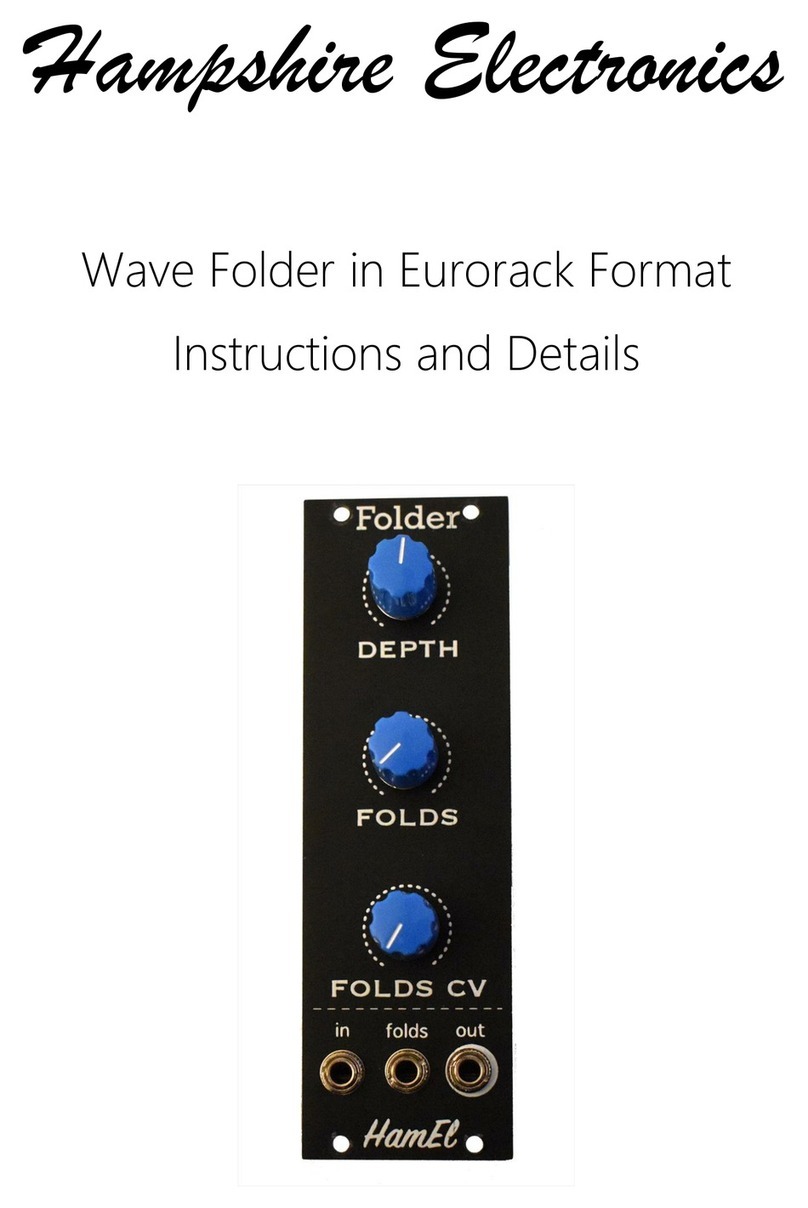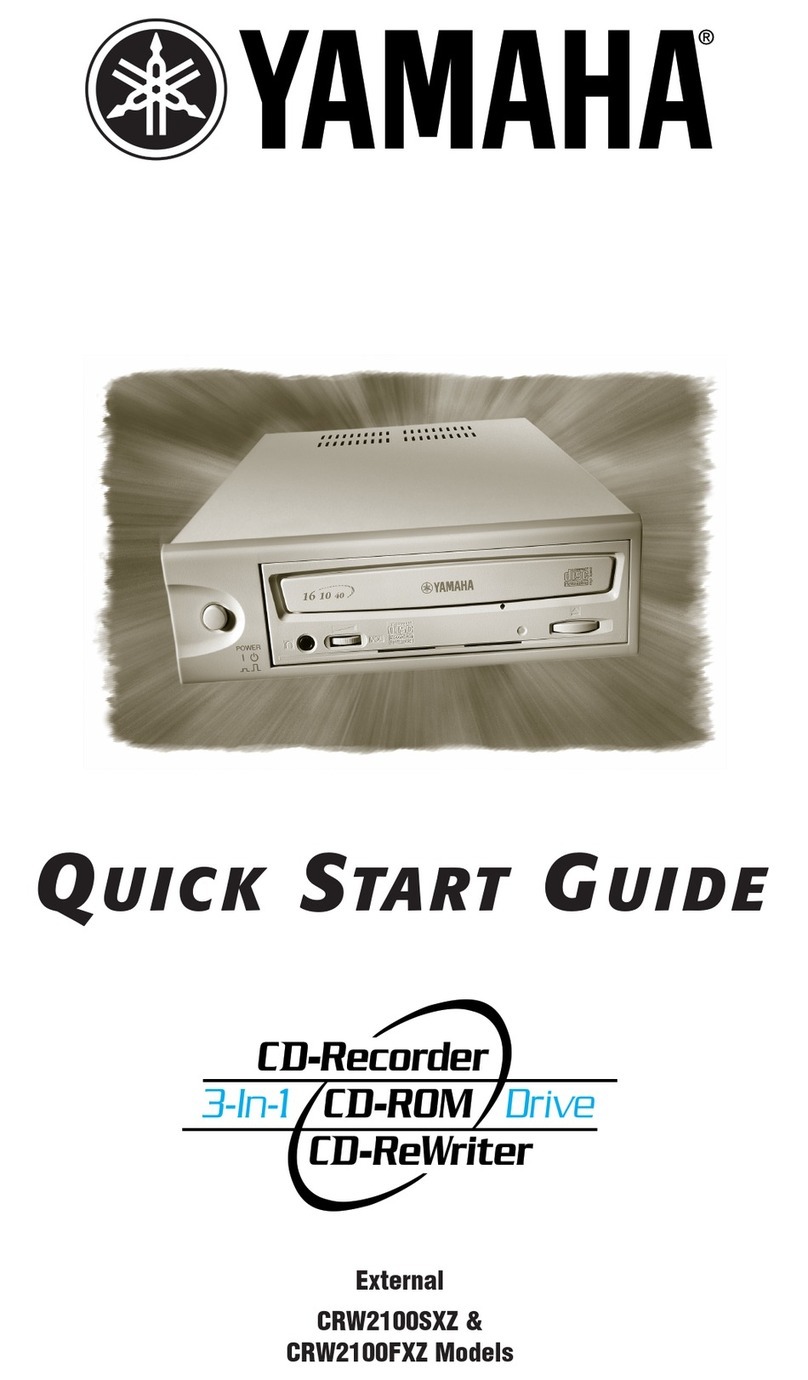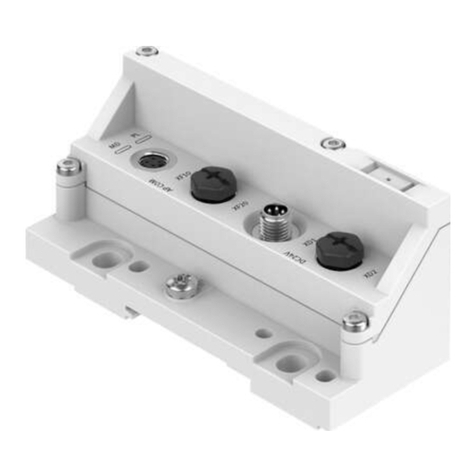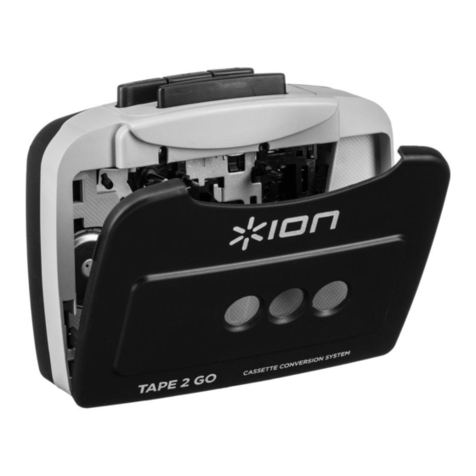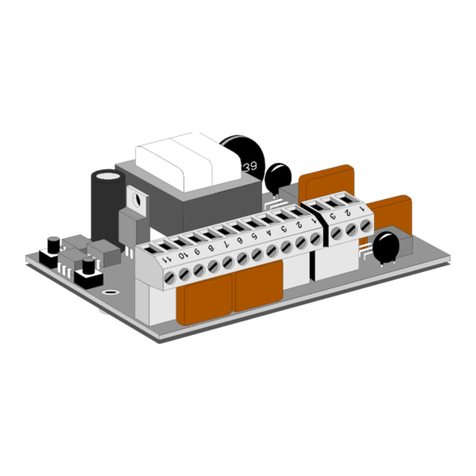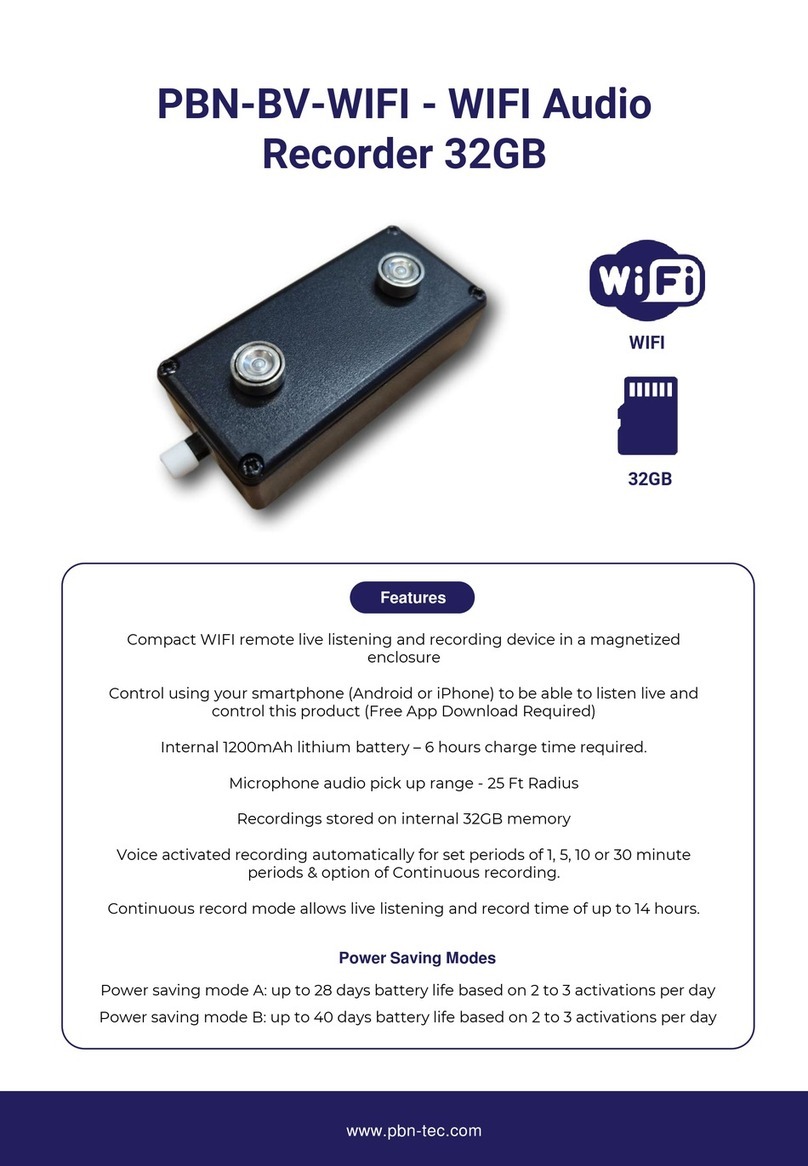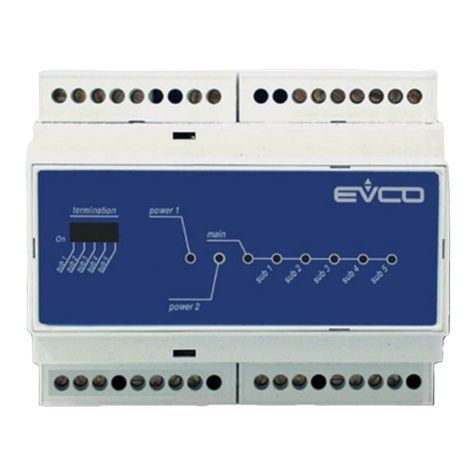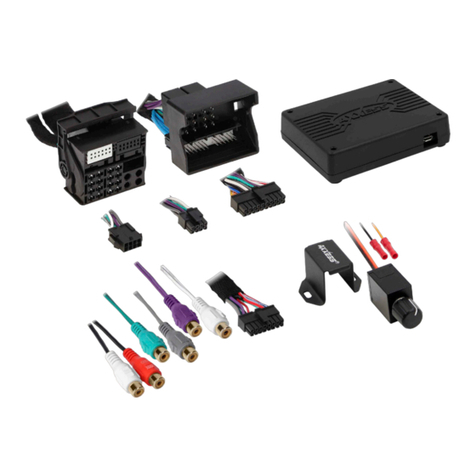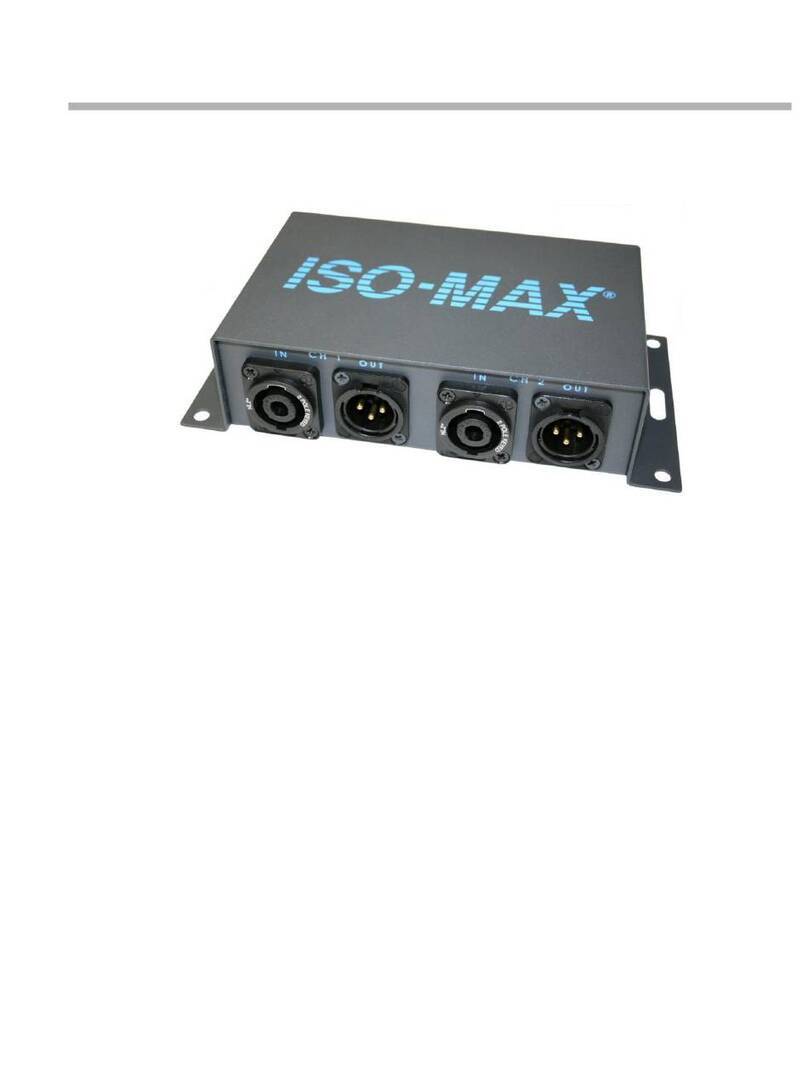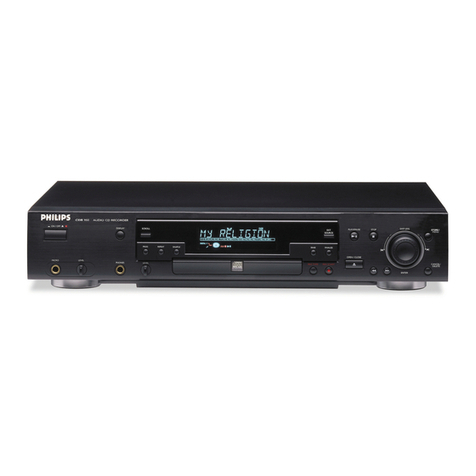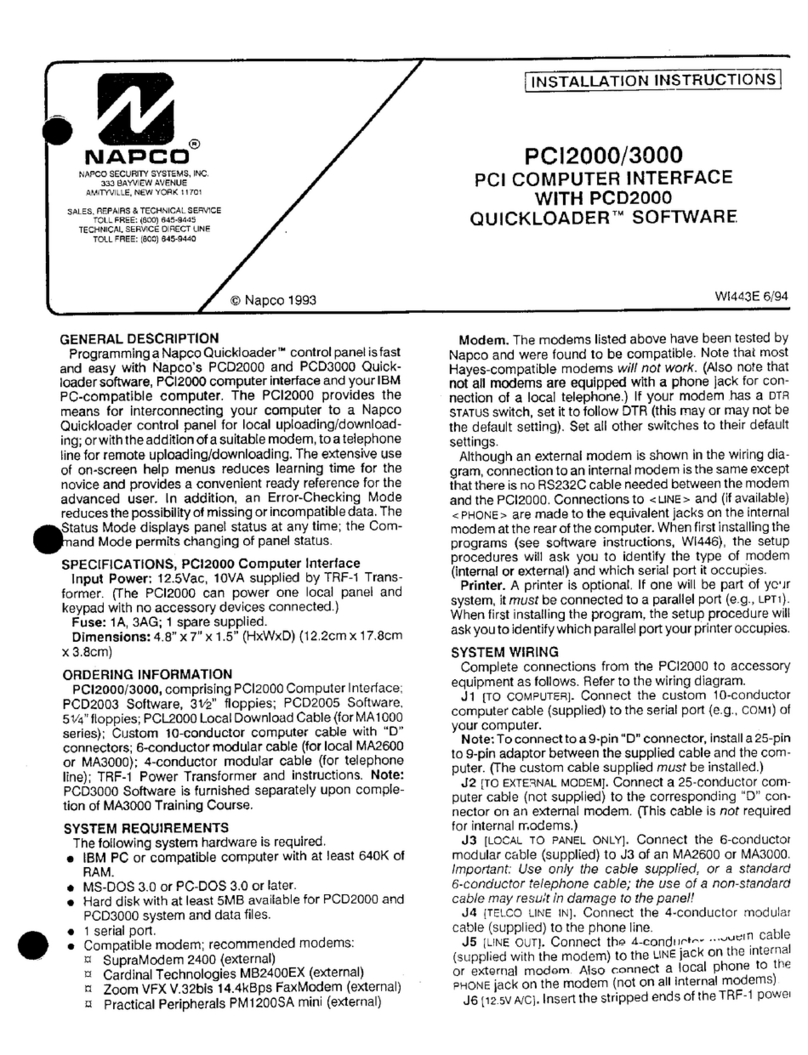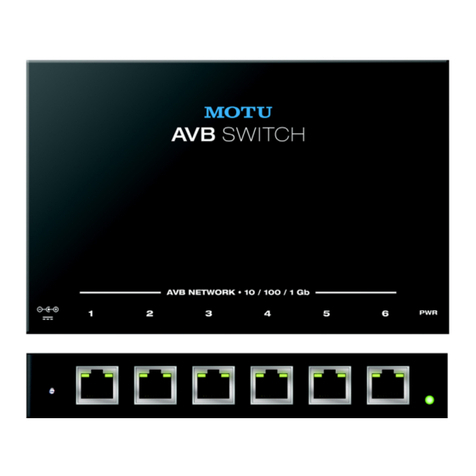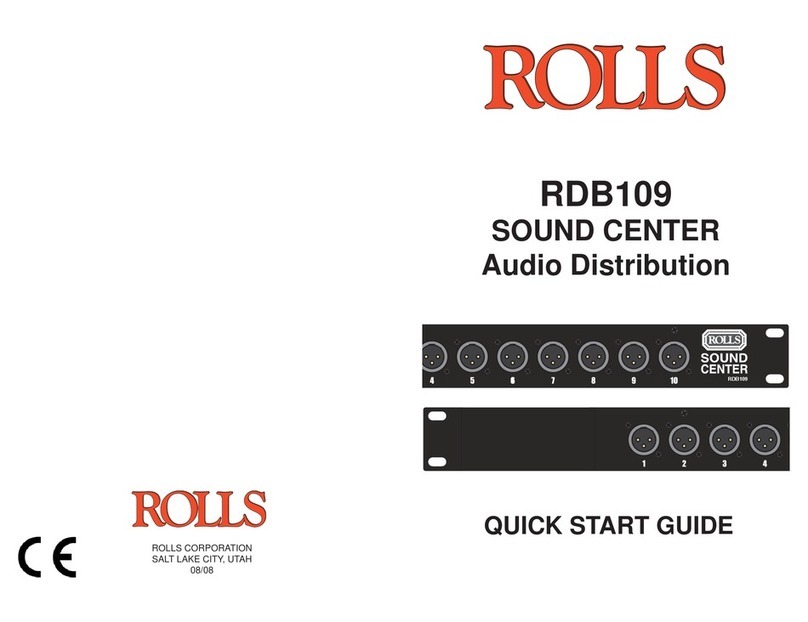OTC IFR-101 User manual

MANUAL NO:E2187-8
OWNER'S MANUAL
FOR
INTERFACE BOX
MODEL: IFR-101 E2187
DO NOT DESTROY
IMPORTANT: Read and understand the entire contents of this
manual, with special emphasis on the safety material throughout
the manual, before installing, operating, or maintaining this
equipment. This equipment and this manual are for use only by
persons trained and experienced in the safety operation of welding
equipment. Do not allow untrained persons to install, operate or
maintain this equipment. Contact your distributor if you do not
fully understand this manual.
DAIHEN Corporation WELDING PRODUCTS DIVISION
January 22, 2009
Upon contact, advise MODEL and MANUAL NO.

Notice : Machine export to Europe
This product does not meet the requirements specified in the EC Directives which are the EU safety
ordinance that was enforced starting on January 1, 1995. Please make sure that this product is not
allowed to bring into the EU after January 1, 1995 as it is.
The same restriction is also applied to any country which has signed the EEA accord.
Please ask us before attempting to relocate or resell this product to or in any EU member country or
any other country which has signed the EEA accord.

No.E2187
P. 1 /26
TABLE OF CONTENTS
1. SAFETY INFORMATION‥‥‥‥‥‥‥‥‥‥‥‥‥‥‥‥‥‥‥‥‥‥‥ 2
2. ARC WELDING SAFETY PRECAUTIONS‥‥‥‥‥‥‥‥‥‥‥‥‥‥‥‥ 2
3. GENERAL NOTICE OF OPERATION‥‥‥‥‥‥‥‥‥‥‥‥‥‥‥‥‥‥ 8
4. STANDARD COMPOSITION AND ACCESSORIES‥‥‥‥‥‥‥‥‥‥‥‥ 9
5. CONNECTION PROCEDURE AND GROUND FOR SAFETY USE‥‥‥‥‥‥ 10
6. MAINTENANCE AND TROUBLESHOOTING‥‥‥‥‥‥‥‥‥‥‥‥‥‥ 20
7. PARTS LIST‥‥‥‥‥‥‥‥‥‥‥‥‥‥‥‥‥‥‥‥‥‥‥‥‥‥‥‥ 21

No.E2187
P. 2 /26
1. SAFETY INFORMATION
The following safety alert symbols and signal words are used throughout this manual to
identify various hazards and special instructions.
WARNING WARNING gives information regarding possible personal injury
or loss of life.
CAUTION CAUTION refers to minor personal injury or possible equipment
damage.
2. ARC WELDING SAFETY PRECAUTIONS
WARNING
ARC WELDING can be hazardous.
1. PROTECT YOURSELF AND OTHERS FROM POSSIBLE SERIOUS INJURY OR DEATH.
Be sure to:
・Keep children away.
・Keep pacemaker wearers away until consulting a doctor.
2. Read and understand the summarized safety information given below and the original
principal information that will be found in the PRINCIPAL SAFETY STANDARDS.
3. Have only trained and experienced persons perform installation, operation, and
maintenance of this equipment.
4. Use only well-maintained equipment. Repair or replace damaged parts at once.
ARC WELDING is safe when precautions are taken.

No.E2187
P. 3 /26
2. ARC WELDING SAFETY PRECAUTIONS (continued)
ELECTRIC SHOCK can kill.
Touching live electrical parts can cause fatal shocks or severe burns. The electrode and work
circuits are electrically live whenever the output is on. The power line and internal circuits of
this equipment are also live when the line disconnect switch is on. When arc welding all metal
components in the torch and work circuits are electrically live.
Leaving piled-up dust in the welding machine may cause insulation deterioration and result in
electrical shock and fire.
1. Do not touch live electrical parts.
2. Wear dry insulating gloves and other body protection that are free of holes.
3. Insulate yourself from work and ground using dry insulating mats or covers.
4. Be sure to disconnect the line disconnect switch before installing, changing torch parts
or maintaining this equipment.
5. Properly install and ground this equipment according to its Owner’s Manual and national,
state, and local codes.
6. Keep all panels and covers of this equipment securely in place.
7. Do not use worn, damaged, undersized, or poorly spliced cables.
8. Do not touch electrodes or any metal object if POWER switch is ON.
9. Do not wrap cables around your body.
10. Turn off POWER switch when not in use.
11. Remove dust by blowing moisture-free compressed air on each part periodically.
ARC RAYS can burn eyes and skin: FLYING SPARKS AND HOT METAL can
cause injury. NOISE can damage hearing.
Arc rays from the welding process produce intense heat and strong ultraviolet rays that can
burn eyes and skin.
Noise from some arc welding can damage hearing.
1. Wear face shield with a proper shade of filter (See ANSI Z 49.1 listed in PRINCIPAL
SAFETY STANDARDS) to protect your face and eyes when welding or watching a welder
work.
2. Wear approved face shields or safety goggles. Side shields recommended.
3. Use protective screens or barriers to protect others from flash and glare: warn others not
to look at the arc.
4. Wear protective clothing made from durable, flame-resistant material (wool and leather)
and foot protection.
5. Use approved earplugs or earmuffs if noise level is high.
Chipping and grinding can cause flying metal. As welds cool, they can throw off slag.
6. Wear proper body protection to protect skin.

No.E2187
P. 4 /26 2. ARC WELDING SAFETY PRECAUTIONS (continued)
WELDING can cause fire and explosion.
Sparks and spatter fly off from the welding arc. The flying sparks, hot metal, spatter, hot base
metal and hot equipment can cause fire and explosion. Accidental contact of electrode or
welding wire to metal object can cause sparks, overheating, or fire.
Leaving piled-up dust in the welding machine may cause insulation deterioration and result in
electrical shock and fire.
1. Protect yourself and others from flying sparks and hot metals.
2. Do not weld where flying sparks can strike flammable material.
3. Remove all flammables within 10m (33ft) of the welding arc. If this is not possible, tightly,
cover them with approved covers.
4. Be alert that welding sparks and hot metals from welding can easily pass through cracks
and openings into adjacent areas.
5. Watch for fire, and keep a fire extinguisher nearby.
6. Be aware that welding on a ceiling, floor, bulkhead, or partition can ignite a hidden fire.
7. Do not weld on closed containers such as tanks or drums.
8. Connect power cable for base metal as close to the welding area as possible to prevent the
welding current from traveling along unknown paths and causing electric shock and fire
hazards.
9. Remove stick electrode from holder or cut off welding wire at contact tip when not in use.
10. Do not use the welding power source for anything other than arc welding.
11. Wear oil-free protective garments such as leather gloves, a heavy shirt, cuffless trousers,
boots, and a cap.
12. A loose cable connection can cause sparks and excessive heating.
13. Tighten all cable connections.
14. When there is an electrical connection between a work piece and the frame of wire feeder
or the wire reel stand, arc may be generated and cause damage by a fire if the wire contacts
the frame or the work piece.
15. Remove dust by blowing moisture-free compressed air on each part periodically.
FUMES AND GASES can be hazardous to your health.
Arc welding produce fumes and gases. Breathing these fumes and gases can be hazardous to
your health.
1. Keep your head out of the fumes. Do not breathe the fumes.
2. Ventilate the area and/or use exhaust at the arc to remove welding fumes and gases.
3. If ventilation is poor, use an approved air-supplied respirator.
4. Read the Material Safety Data Sheets (MSDS) and the manufacturer’s instructions on
metals, consumables, coatings, and cleaners.
5. Do not weld or cut in locations near degreasing, cleaning, or spraying operations.
The heat and arc rays can react with vapors to form highly toxic and irritating gases.
6. Work in a confined space only if it is well ventilated, or while wearing an air-supplied
respirator. Shielding gases used for welding can displace air causing injury or death.
Be sure the breathing air is safe.

No.E2187
P. 5 /26
2. ARC WELDING SAFETY PRECAUTIONS (continued)
CYLINDER can explode if damaged.
A shielding gas cylinder contains high-pressure gas. If damaged, a cylinder can explode.
Since gas cylinders are normally part of the welding process, be sure to handle them carefully.
1. Use only correct shielding gas cylinders, gas regulator, hoses, and fittings designed for the
specific application; maintain them in good condition.
2. Protect compressed gas cylinders from excessive heat, mechanical shock, and arcs.
3. Keep the cylinder upright and securely chained to a stationary support or a rack to prevent
falling or tipping.
4. Keep cylinders away from any welding or other electrical circuit.
5. Never touch cylinder with welding electrode.
6. Read and follow instructions on compressed gas cylinders, associated equipment, and the
CGA publication P-1 listed in PRINCIPAL SAFETY STANDARDS.
7. Turn face away from the valve outlet when opening cylinder valve.
8. Keep protective cap in place over valve except when a gas cylinder is in use or connected
for use.
9. Do not disassemble or repair the gas regulator except if you are authorized by the
manufacturer.
Rotating parts may cause injuries. Be sure to observe the following.
If hands, fingers, hair or clothes are put near the fan’s rotating parts or wire feeder’s feed roll,
injuries may occur.
1. Do not use this equipment if the case and the cover are removed.
2. When the case is removed for maintenance/inspection and repair, certified or experienced
operators must perform the work. Erect a fence, etc. around this equipment to keep others
away from it.
3. Do not put hands, fingers, hair or clothes near the rotating fans or wire feed roll.

No.E2187
P. 6 /26 2. ARC WELDING SAFETY PRECAUTIONS (continued)
ARC WELDING work areas are potentially hazardous.
FALLING or MOVING machines can cause serious injury.
1. When hanging the welding power source by a crane, do not use the carrying handle.
2. Put the welding power source and wire feeder solidly on a flat surface.
3. Do not pull the welding power source across a floor laid with cables and hoses.
4. Do not put wire feeder on the welding power source.
5. Do not put the welding power source or wire feeder where they will pit or fall.
WELDING WIRE can cause puncture wounds.
1. Do not press the gun trigger until instructed to do so.
2. Do not point the gun toward any part of the body, other people, or any metal when
threading welding wire.

No.E2187
P. 7 /26
PRINCIPAL SAFETY STANDARDS
Arc welding equipment – Installation and use, Technical Specification
IEC 62081, from International Electro technical Commission
Arc welding equipment Part 1: Welding power sources IEC 60974-1, from International Electro
technical Commission
Safety in Welding and Cutting, ANSI Standard Z49.1, from American Welding Society.
Safety and Health Standards, OSHA 29 CFR 1910, from Superintendent of Documents, U.S.
Government Printing Office.
Recommended Practices for Plasma Arc Cutting, American Welding Society Standard AWS C5.2,
from American Welding Society.
Recommended Safe Practices for the Preparation for Welding and Cutting of Containers That Have
Held Hazardous Substances, American Welding Society Standard AWS F4.1, from American
Welding Society.
National Electrical Code, NFPA Standard 70, from National Fire Protection Association.
Safe Handling of Compressed Gases in Cylinders, CGA Pamphlet P-1, from Compressed Gas
Association.
Code for Safety in Welding and Cutting, CSA Standard W117.2, from Canadian Standards
Association, Standards Sales.
Safe Practices For Occupation And Educational Eye And Face Protection, ANSI Standard Z87.1,
from American National Standards Institute.
Cutting And Welding Processes, NFPA Standard 51B, from National Fire Protection Association.
NOTE: The codes listed above may be improved or eliminated. Always refer to the updated codes.
M080904

No.E2187
P. 8 /26
3. GENERAL NOTICE OF OPERATION
Thank you for your purchasing IFR-101 type Interface box. This equipment is an interface
box which can be used for combining CO2/MAG/MIG welding manufactured by Daihen
with arc welding robot manufactured by Yasukawa Electric. Please carefully read the
following description for using this machine correctly
3.1 Machines to be combined
The welding machines which can be combined with this interface box are as listed below.
Model Type Remarks
Inverter auto 180 CPV-180
Inverter auto 350 CPV-350
Inverter auto 500 CPV-500
Inverter auto 600 CPV-600
Micro 180 CPVMB-180
Fuzzy auto 200 CPD-200
Fuzzy auto 350 CPD-350
Fuzzy auto 350 EX CPDB-350
Fuzzy auto 500 CPD-500
Digital pulse 350 CPDP-350 *1
Digital pulse 500 CPDP-500 *1
Digital pulse auto 350 CPDPA-350 *1
Digital pulse auto 500 CPDPA-500 *1
Digital wave pulse 350 CPDWP-350 *1
Digital wave pulse 500 CPDWP-500 *1
DR-350 CPDR-350 *1, *2
DR-500 CPDR-500 *1, *2
Digital AC wave 200 CPDACR-200 *2
Inverter auto 350 TB CPVB-350 *3, *4
Turbo pulse 350 CPVP-350 *3, *4
Turbo pulse 500 CPVP-500 *3, *4
Inverter MIG pulse auto 350 CPVPA-350 *3
Inverter MIG wave pulse 350 CPVWP-350 *5
Inverter MIG wave pulse 500 CPVWP-500 *5
*1: When using a wire feeder with 4P plug such as CMR-231Adapter connector K5076B is
needed.
*2: For the use of CMRE-231, use a control cable for CMRE-231.
*3: Use E1984G01 (optional accessory).
*4: Use a special power source to output arc generation detection signal to (M) and (N) pins
of canon plug for robot connection.
*5: Use E1984M00 or E1984J00 (optional accessory).

No.E2187
P. 9 /26
4. STANDARD COMPOSITION AND ACCESSORIES
4.1 Interface box
Model IFR-101
*Input voltage / phase 380 / 400 / 415 / 440 / 460 ±10 % V AC,
single phase
Rated frequency 50 / 60 Hz
External dimensions(W×D×H) 100×330×192 mm
(Not including attachment plates, screws and
projection nuts)
* User-defined input voltage
4.2 Standard accessories
●Your package contains the accessories shown in the table below. Check the quantity.
Description Specification Q’ty Remarks
Wire harness (1) E1984K01 1 Connection for CMH type wire feeder
Wire harness (2) E1984K02 1 Connection for CMH type wire feeder
Vinyl wire VSF 1.25 G 1 Grounding
Pressure terminal R 1.25 – 4 1 For grounding
Pressure terminal R 1.25 – 6 1 For grounding
Glass enclosed fuse 1A 250V 1
Glass enclosed fuse 3A 250V 1
4.3 Optional accessories
Description Specification Q’ty Remarks
Conversion cable K5076B00 1 set For connection to CPDP
Arc voltage detection wire K2809B00 1 set
For connection to CPDP
Receptacle for detection of
lack of gas BBPU-3010 1 set
WF6220
Receptacle for detection of
lack of wire DPC25-2A 1 set
Adapter for CPVP(A), CPVB E1984M00 1 set
For connection to CPVP(A), CPVB
Adapter for CPVWP E1984J00 1 set For connection to CPVWP
Adapter component for CPVWP (E1984J00)
Description Specification Q’ty
Wire harness (1) E1984J01 1
Wire harness (2) E1984J02 1
Relay assembly E1984J03 1
Adapter component for CPP(A), CPVB (E1984M01)
Description Specification Q’ty
Wire harness E1984G01 1

No.E2187
P. 10 /26
5. CONNECTION PROCEDURE AND GROUND FOR SAFETY USE
5.1 Installation WARNING
Observe the following to prevent the electrical shock.
●In touching the live electrical part, critical electric shock and burn may occur.
●Do not touch live electrical part inside and outside of the welding power source.
●Grounding to the case of the welding power source should be performed by persons
qualified in electric work according to laws and regulations.
●Be sure to turn off the line disconnect switch before connecting.
●Do not use cables with insufficient capacity, damaged or exposing the conductor.
●Securely tighten each connection.
●Securely attach the case and cover after connecting cables.
1. Remove the upper cover of the welding power source.
2. Hook the interface box on the right side board of the welding power source.
3. Close the upper cover of the welding power source.
Welding power source Interface box

No.E2187
P. 11 /26
5.2 Connection of a control cable
5.2.1 Connection with CPV-180, 350, 500 and 600
・Connect the 6P plug on the interface box to the “Remote control” receptacle of the
welding power source.
・Connect the 4P plug on the interface box to the “Wire feeder” receptacle of the welding
power source.
・Connect the 4P plug on wire feeder such as CMR-231 to the “Wire feeder” receptacle
located on the rear side of the interface box.
・Connect the control wires (No. 8, 9, 25, and 59) connected with the interface box to the
terminal block inside the welding power source (on P.C.B.P6768Q).
Welding power source
Interface box
Wire feeder
To terminal block inside
welding power source
To “Remote control ”
receptacle (6P)
To “Remote control”
receptacle (4P)
12P terminal block
ガスバルブ開閉
(閉でガス放流)
GAS SOLENOID
VALVE CONTROL
(Gas purge when
short-circuited)
電源準備
リレー(DC 24V)
POWER FOR
PREP.RELAY
(DC 24V)
電流計
AMMETER
電圧計
VOLTMETER
溶接電流リレー
(WCR)接点
WELD.CURR.
RELAY (WCR)
CONTACT
非常停止
(開で停止)
OPERATION STOP
(Normally closed.
Stop when open.)

No.E2187
P. 12 /26
5.2.2 Connection with CPD-200, 350, 500 and CPDB-350
・Connect the 6P plug on the interface box to the “Remote control” receptacle of the
welding power source.
・Connect the 4P plug on the interface box to the “Wire feeder” receptacle of the welding
power source.
・Connect the 4P plug on a wire feeder such as CMR-231 to the “Wire feeder” receptacle
located on the rear side of the interface box.
・Follow the diagram shown below to connect the control wires (No. 8, 9, 25, and 59)
connected with the interface box to the terminal block for external connection (on
P.C.B.P6768Q) inside the front cover.
Welding power source
Wire feeder
Interface box
To “Terminal block for
external connection”
12P terminal bloc
k
電流計
AMMETER 電圧計
VOLTMETER 非常停止
(開で停止)
OPERATION STOP
(Normally closed.
Stop when open.)
電源準備
リレー
接点
POWER FOR
PREP.RELAY
ガスバルブ
開閉
GAS SOLENOID
VALVE CONTROL
(Gas purge when
shor
t
-circuited
)
溶接電流
リレー(WCR)
接点
WELD.CURR.
RELAY (WCR)
CONTACT
To “Remote control”
receptacle (6P) To “Wire feeder”
receptacle (4P)

No.E2187
P. 13 /26
5.2.3 Connection with CPDP-350, 500, CPDPA-350, 500, and CPDWP-350, 500
(1) Using a plug wire feeder with 4P plug
When using a wire feeder with 4P plug such as CMR-231, use a conversion connector
(K5076B).
・Connect the 6P plug on the interface box to the “Remote control” receptacle of welding
power source.
・Connect a conversion cable (K5076B) to the 4P plug on the interface box and “Wire
feeder” receptacle (7P) of the welding power source.
Connect an arc voltage detection wire included in K5076B to the points in a torch or a
wire feeder, at which arc voltage can be detected. (If arc voltage detection wire length is
not long enough to make the connection, extend the arc voltage detection wires, K2809B.)
・Connect the 4P plug on wire feeder such as CMR-231 to the “Wire feeder” receptacle
located on the rear side of the interface box.
・Connect control wires (No. 8, 9, 25, and 59) connected with the interface box to the
terminal block (located on the upper side of P.C.B.P6768Q) inside the welding power
source.
・When using CMR-231, switch the wire feeder by using change-over switch for their
different feeding speeds. (Refer to the manual on the welding power source for
changing over a wire feeder.)
Welding power source
Wire feeder
Interface box
Arc voltage detective wire
Connect to torch (or wire
feeder).
To terminal block inside
welding power source
To “Remote control”
receptacle (7P)
To “Wire feeder”
receptacle (4P)
To conversion cable
K5076B

No.E2187
P. 14 /26
(2) Using a wire feeder with 7P plug
When using a wire feeder with 7P plug such as CMH-2301 and CMH-1405, use accessory
wires (E1984K01 or E1984K02) to change the receptacle of the wire feeder from 4P to 7P.
Refer to schematic diagram 2 for the connection.
Connecting E1984K01/E1984K02
1. Remove 4P plug and 4P receptacle on the interface box.
2. Install wire harness 1 (E1984K01) instead of 4P plug, and connect it to CN5 on
P.C.B.E1984D.
3. Install wire harness 2 (E1984K02) instead of 4P receptacle and connect it to CN7 on
P.C.B.E1984D.
4. Connect L connectors of wire harness 1 and 2.
Refer to section 5.2.1 for the following connections.
Wire harness 1
Replace this wire
with E1984K01
L connector
P.C.B.
E1984D
Wire harness 2
Replace this wire with E1984K02

No.E2187
P. 15 /26
5.2.4 Connection with CPDR-350, 500, CPDACR-200
(1) Using a wire feeder with plug 4P
When using a wire feeder with 4P plug such as CMR-231, use a conversion connector
(K5076B). Refer to section 5.2.3 (1) for the connection. Also, change to “wire feeder
no-encoder” inside the welding power source. Refer to the manual on welding power
source for the change-over to “Wire feeder no-encoder”.
(2) Using CMH-type wire feeder
When using a wire feeder with 7P plug such as CMH-2301 and CMH-1405, use an
optional wire (E1984K01 or E1984K02). Refer to section 5.2.3 (2) for the connection.
Also, change over to “wire feeder no-encoder” inside welding power source. Refer to
the manual for the change-over to “wire feeder no-encoder”.
(3) Using CMRE-231 type wire feeder
When using wire feeder CMRE-231, use an optional wire (E1984K01 or E1984K02).
Refer to section 5.2.3 (2) for the connection. Also, use a CMRE control cable (optional
accessory). It directly connects welding power source and wire feeder through no
interface box.
To terminal block
on P.C.B.P6981Q
Control cable
(
7P
)
Control cable for CMRE-231
Robot controlle
r
Interface for robot
Base metal cable
Base metal
Control cable
(
7P
)
Control cable
(
6P
)
To
r
ch-side cable
Wire feeder
CMRE-231
CPDACR-200
CPDACR-200
CPDR-350/500

No.E2187
P. 16 /26
5.2.5 Connection with CPVP-350, 500, CPVB-350 and CPVPA-350
When combining with CPVP-350, 500, CPVB-350 and CPVPA-350, use an adapter for
CPVP (A) and CPVB (E1984M00). Refer to schematic diagram 3 for the connection.
・Connect the 6P plug on the interface box to the “Remote control” receptacle of the
welding power source.
・Connect the 4P plug on the interface box to the “Wire feeder” receptacle of the welding
power source.
・Connect the 4P plug on wire feeder such as CMR-231 to the “Wire feeder” receptacle
located on the rear side of the interface box.
・Connect the 8P plug (wire harness E1984G01) on the interface box to the “Automatic
machine” receptacle of welding power source.
5.2.6 Connection with CPVWP-350 / 500
10P terminal block
Wire harness
(optional accessory)
E1984G01 8P plug
Connecting E1984M00
1. Remove 4P cables (No.8, 9, 25 and 59)
which are connected to the 10P terminal
block on the interface box.
2. Follow the drawing shown right to connect
wire harness (E1984G01).
Welding power source
For “Automatic
machine” receptacle (8P)
Wire feeder
Interface box
To “Remote control”
receptacle (6P)
To “Wire feeder”
receptacle (4P)

No.E2187
P. 17 /26
When combining with CPVWP-350 or 500, use optional adapter for CPVP (A), CPVB
(E1984M00) and adapter for CPVWP (E1984J00). The adapters change the receptacle
of the wire feeder from 4P to 5P. Refer to schematic diagram 4 for the connection.
Connecting E1984J00
1. Remove 4P plug and 4P receptacle.
2. Install wire harness 1 (E1984J01) instead of 4P plug and connect CN5 on
P.C.B.E1984D.
3. Install wire harness 2 (E1984J02) instead of 4P plug and connect CN7 on
P.C.B.E1984D.
4. Install relay assembly (E1984J03).
5. Connect the plug connected to relay assembly (E1984J03) with the plug receptacle
connected to canon receptacle.
6. Connect the wire (No.12) connected to relay assembly (E1984J03) with “12” on
10P terminal block.
7. Connect the L connectors connected to wire harness 1 and 2 with the L connectors
connected to relay assembly.
Refer to section 5.2.5 on the other connections.
P.C.B.
E1984D
L connectors
Relay assembly
E1984J03
Plug
(receptacle)
connection
10P terminal
b
loc
k
10P terminal
b
loc
k
Wire harness 1
(optional accessory)
E1984J01
Wire harness
(optional accessory)
E1984G01
Wire harness 2
(optional accessory)
E1984J02
Canon
receptacle
8P
p
lu
g
5P
p
lu
g

No.E2187
P. 18 /26
5.3 Connection with a robot manufactured by Yasukawa Electric
Connect the connector connected to a Yasukawa Electric’s robot with the canon
receptacle of “robot controller”. Connect to each connector to detect lack of gas and lack of
wire. (Receptacle for connection to detect lack of gas: BBPU-3010, receptacle for
connection to detect lack of wire: DPC25-2A)
The relation between pin numbers and signals for connection with Yasukawa Electric’s
robot canon receptacle is as follows:
(1) (A) – (B)
Welding voltage commanding signal
Output voltage of welding power source depends on 0 to 15V DC input voltage.
(2) (C) – (D)
Welding current commanding signal
Wire feeding speed (welding current) depends on 0 to 15V DC input voltage.
(3) (F) – (G)
Input of wire inching signal
Wire is fed by short-circuiting between (F) and (G).
(4) (L) – (K)
Input of weld starting signal (contact signal)
Welding operation can be started by short-circuiting between (L) and (K).
(5) (H) – (J)
Input of wire retract signal (contact signal)
Wire is retracted by short-circuiting between (H) and (J).
(6) (M) – (N)
Supply output terminal voltage from a welding power source
(M): +, (N): 0 V
(7) (S) – (E)
Output of detection signal for lack of gas
Between (S) and (E) are closed due to lack of gas. In that case, contact signals from
flowmeter with pressure contacts must be connected to “Gas pressure detection input”.
(8) (P) – (E)
Output of detection signal for arc generation
Between (P) and (E) is closed by outputting arc generation detection signal.
(9) (R) – (E)
Output of detection signal for lack of wire
Between (R) and (E) is “Closed” when weld starting signal holds “Closed” state and arc
generation detection holds “Open” state for period of time. (Warning time can be set by
TDR built in P.C.B.)
(10) (T) – (E)
Output of detection signal for wire reduction
Closed contacts between (T) and (E) will caused by wire reduction. In that case, signal
for wire reduction must be connected to the connectors to detect for lack of wire.
Table of contents
